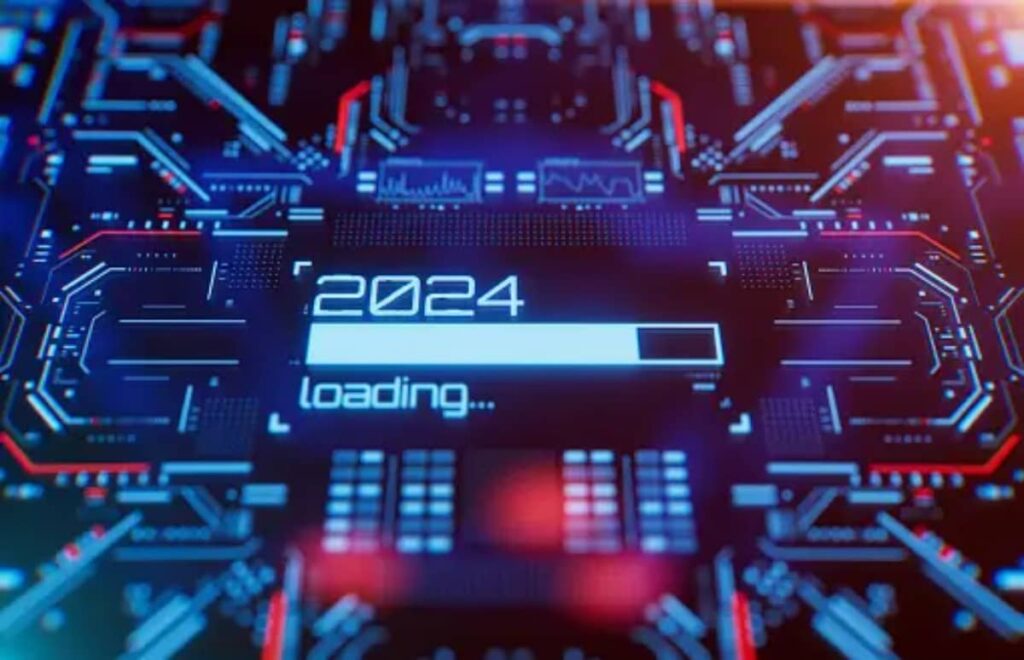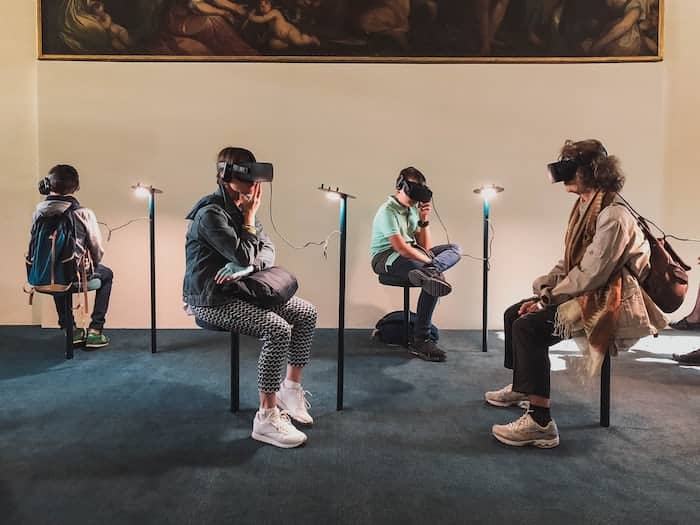
In this post, we will explore up-coming New Technology Trends For 2024.
As 2023 kicks into high gear, exciting emerging tech breakthroughs point to some major digital shifts on the horizon. From AI advancements to innovations in sustainability and transportation, the technological landscape in 2024 promises innovative disruptions across every industry.
Let’s explore up-and-coming technology trends to go mainstream within the next year and revolutionize, how we work and live on both business and consumer levels globally.
Artificial Intelligence
AI Capabilities Get More Sophisticated
We’ll continue seeing exponential growth in AI sophistication during 2024, including enhancements in machine learning, neural networks, robotic process automation (RPA) and edge computing. As more companies embed AI into data analytics, operations and customer experience, expect AI adoption to soar across enterprises big and small.
- AI Researcher: Delving deep into the development of advanced generative models. Its more completable for us.
- Data Scientist: Using generative AI to extract valuable insights from data.
- Content Creator: Harnessing generative AI for innovative storytelling. Best prompt can get vest content.
- AI Ethics Consultant: Addressing the ethical implications of AI-generated content.
AI Chips Supercharge Performance
Specialized AI semiconductor chips known as AI accelerators and neural processors are decreasing cost and energy usage while drastically boosting speed and capabilities compared to CPU/GPU-based AI modeling. Major players like Cerebras, Graphcore and SambaNova will likely release second-generation AI chips packing more performance punch, fueling the scale of complex enterprise AI applications.
Industries Increase Reliance on AI
More industries will bake AI into their tech stacks and daily operations for enhanced efficiency, insights and decision-making support. We’ll see AI elevate healthcare diagnostics, boost supply chain resilience for manufacturers, enrich self-driving vehicle systems for transport, and much more. The AI landscape will expand across verticals in 2024.
Quantum Computing

More Accessible Quantum Hardware
Quantum computing hit major milestones recently with IBM unveiling its 433-qubit processor. Quantum hardware availability will keep growing in 2024, providing developers more robust systems to experiment. Increased access is accelerating widespread quantum adoption. Startups will also enter offering quantum platforms via the cloud.
Algorithms and Programming Languages Evolve
Current quantum algorithms remain limited, but new approaches are emerging like quantum machine learning models. As hardware capabilities improve, developers now must evolve programming languages, cybersecurity mechanisms, debuggers and more tailored to quantum’s unprecedented power.
Real-World Applications Gain Traction
When will quantum drift out of hype into practicality? commercially-viable use cases will gain traction across chemicals, logistics, finance and more verticals needing complex modeling. Government funding and cloud services that reduce infrastructure strains will further catalyze short-term quantum wins we’ll witness in 2024.
- AI Engineer
- Scientist
- AI Architect
- Robotics Researcher
- Robotics Designer
Augmented and Virtual Reality

AR Glasses 2.0 Improve Usability
Many tech giants are betting big on augmented reality eventually becoming an indispensable smart device staple. The failure of Google Glass dampened mainstream AR glasses adoption previously. But vendors like Microsoft, Facebook/Meta and Apple are prepping lighter-weight AR glasses boasting enhanced voice control, gesture recognition and 3D mapping to recapture consumer enthusiasm in 2024.
VR Content Catalogs & Use Cases Diversify
From exercise apps to surgical training simulations to industrial design software, virtual reality worlds are expanding far beyond gaming roots into diverse verticals as headsets get cheaper and more powerful. The global VR market is estimated to grow by 43% annually through 2028 as more affordable all-in-one solutions like Meta Quest make immersive experiences broadly accessible.
XR Merges Physical and Digital Worlds
As augmented and virtual capabilities converge, a spatial computing paradigm called the “XRverse” promises to bridge our physical and online worlds smoothly. Web giants are investing heavily in XR infrastructure expected to revolutionize hybrid work and telepresence. XRVERSE protocols that allow multiuser virtual spaces to mirror real-time room layouts and human movement will start emerging from labs next year.
3D Printing
A key trend in innovation and technology is 3D printing used to create prototypes. This technology has become influential in the biomedical and industrial sectors. None of us thought of printing a physical object from a printer, although it is now a reality. So, 3D printing is another innovation that is here to stay. For companies in the data and healthcare sectors that need a lot of 3D printing for their products, the various jobs are well-paid and international. You only need proper knowledge of AI, machine learning, modeling and 3D printing. Let’s take a look at the best jobs in this specialization:
- AI Engineer
- Operations Manager
- Emulation Prototyping Engineer
- Organ & Prosthetic Designer
- Robotics Trainer
- CX Program Manager
- 3D Printer Engineer
Cybersecurity
Improved Threat Detection Through XDR
As sophisticated hackers persist with intrusion tactics, extended detection and response (XDR) adds much-needed visibility, automation and analysis across fragmented security tools. XDR’s holistic data ingestion identifies abnormal behaviors and accelerates incident response via centralized dashboards. Enterprise security teams will increasingly shift towards these AI-enhanced XDR platforms in 2024 to battle escalating cybercrime.
Passwordless Authentication Goes Mainstream
The vulnerable password’s days are numbered as hacks expose their inherent flaws. Secure passwordless authentication provides superior identity protection using biometrics and FIDO standards. From facial recognition access controls to hardware security keys, leading IT giants are backing passwordless login methods that consumers and companies will swiftly adopt in 2024 as the safer default.
Boosting Cloud Security Posture Management
Migrating workflows to the cloud sparks new data protection and compliance urgencies. Cloud security posture management (CSPM) platforms are gaining immense traction by using automation, analytics and machine learning to lock down cloud-first ecosystem risks across complex infrastructure and application layers via ongoing posture assessments.
Sustainability Technology
Supply Chain Tracking Tools Grow
Environmentally-conscious consumers and regulators demand unprecedented supply chain transparency from brands to substantiate ethical sourcing and sustainability claims. Emerging startups are rolling out end-to-end software solutions to trace raw materials’ precise origins via IoT sensors, blockchain ledgers and machine learning with detailed geospatial and carbon emission analytics.
Smart Agriculture Cuts Resource Waste
Feeding communities while decreasing agriculture’s massive environmental footprint is a formidable challenge. Cutting-edge smart farming equipment like AI-enabled crop disease detection drones, low-power irrigation sensors and automated robotic harvesters will gain adoption to reduce resource waste and boost climate-resilient crop yields.
Renewable Energy Storage Advances
As renewable energy reliance swells globally, solving solar and wind power’s intermittent generation hurdles is crucial for transitioning away from fossil fuels. Next-gen advancements like compressed-air storage plants, grid-scale liquid air batteries and hydrogen fuel cell facilities promise to soon provide mass power storage and flexible energy delivery from clean sources.
Fintech & Cryptocurrency
Crypto Payments Infiltrate E-commerce
Despite the “crypto winter” price plunges of 2022, blockchain developers keep building the infrastructure for digital asset adoption. As regulators provide clearer crypto guidance, ecommerce giants already accepting tokens like Ethereum and Bitcoin via Coinbase integration will pave the way for smaller merchants embracing convenient crypto payments too.
DeFi Platforms Compete With Banks
Decentralized finance (DeFi) bypasses traditional intermediaries like banks using transparent peer-to-peer protocols atop secure blockchain rails. Looking to lure the unbanked and tap Gen Z prefences, DeFi’s broadening ecosystem now spans crypto savings accounts, insurance coverage, secured loans, robo-advisors and more. Slick user experiences will soon make DeFi’s independence alluring for average consumers.
Stablecoins Secure Backup Assets
The volatility associated with pioneering cryptocurrencies often hinders everyday purchases. But a new breed of price-stable digital tokens pegged to fiat currency values called stablecoins offer the best of both worlds in decentralized, blockchain-verified digital money without the wild value fluctuations. Look for leading stablecoins like USDC to potentially displace traditional currency transaction volumes by 2025.
Genomics
Imagine a technology that can study and use your DNA to improve your health, help you fight disease and what not! Genomics is the technology that studies the make-up of genes, DNA, their mapping, structure, etc. Additionally, it can help quantify your genes and thereby find diseases or potential problems that may lead to health problems later on. When it comes to a specialization like genomics, one can find various technical as well as non-technical roles. Technical jobs in this area are about design, analysis and diagnostics, while non-technical jobs are concerned with higher level research and theoretical analysis. Here are the top jobs in genomics:
- Genetics Engineer
- Genome Research Analyst
- Bioinformatician
- Software Engineer
- Full Stack Developer
- Bioinformatics Analyst
Smart Cities & Infrastructure
Ubiquitous IoT Sensors
Internet of Things (IoT) devices embedded throughout urban environments already provide a constant stream of critical operational data to city councils and utilities. In 2024, upgraded power grids, traffic systems, pollution monitors and public transportation fleets will utilize more of these networked sensors and AI-fueled analytics to direct real-time service adjustments for optimizing efficiency and livability across metropolitan hubs.
EV Charging Networks Expand
Electric vehicles still come saddled with range anxiety given insufficient public charging station access in many regions presently. But thanks to government EV infrastructure funding and charger manufacturing scale, expansive high-speed charging station rollouts will finally accelerate in 2024 throughout highways and urban centers to spark mass EV adoption by eliminating refueling hurdles.
Smart Power Grids Balance Supply & Demand
Aging electrical infrastructure strains to support surging power demands. Using automated metering infrastructure, microgrid controllers and intelligent data monitoring tools, tomorrow’s smarter power grids will dynamically optimize electricity distribution leveraging IoT sensors, cloud analytics and advanced fiber optic connections to balance supply and demand in real-time across wider areas with minimal service interruptions.
Commercial Space Industry
Reusable Rockets Slash Launch Costs
SpaceX’s Falcon 9 reusable rocket design revolutionized affordable satellite deployment and ISS supply transport by landing its booster safely post-takeoff for quick turnaround relaunches. Competing rocket builders like Blue Origin, Rocket Lab and ULA are now testing similar vertical landing reusable systems to make space access flexible and cost-effective. This kicks off a wave of private spaceflights in 2024.
Space Tourism Liftoff
Well-funded space companies are racing to launch the first civilian orbital and suborbital spaceflights offering short-term stays for wealthy thrill-seeking space tourists by 2025. Between Blue Origin’s sleek New Shepard capsule and SpaceX’s high-capacity Starship system currently in development, everything is aligning for the dawn of consumer space travel waving from launch pads next year.
Satellite Mega-Constellations Enhance Connectivity
Preceding generations of costly, hulking communications satellites serving specific clients are getting replaced by concentric rings of smaller, cheaper satellites numbering in the thousands. SpaceX Starlink leads this new mega-constellation pack beaming affordable high.

